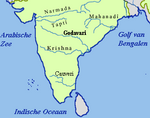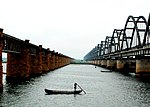| Kadva river | |
|---|---|
 | |
| Location | |
| Country | India |
| State | Maharashtra |
| District | Nashik |
| City | Niphad |
| Physical characteristics | |
| Source | Sahyadris |
| • location | Dindori Taluka, Nashik District, Maharashtra |
| • coordinates | 19°58′27″N73°56′12″E / 19.97417°N 73.93667°E |
| Mouth | Godavari River |
• location | Nandur Madhyameshwar, Nashik, Maharashtra |
• coordinates | 19°10′46″N73°02′24″E / 19.17944°N 73.04000°E |
• elevation | 550 m (1,800 ft) |
| Length | 74 km (46 mi) |
| Basin size | 1,664 km2 (642 sq mi) |
| Basin features | |
| Tributaries | |
| • left | Unanda River, Vinita River |
| • right | Kolwan River, Dhaman River |
Kadva river is a minor but important tributary of Godavari in Nashik district, Maharashtra, India. It originates and flows through the Dindori Taluka of Nashik District.



